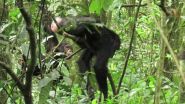New research from Lawson uncovers important molecule in ovarian cancer
Molecule plays pivotal role in making ovarian cancer cells so lethal
2015-07-22
(Press-News.org) Scientists at Lawson Health Research Institute have uncovered an important new target for ovarian cancer therapy. Contrary to current research this new study found that LKB1, a molecule that regulates the metabolism of many adult cells, is an important molecule in the cancer's promotion and survival.
Thousands of women are living with ovarian cancer in Canada. It is estimated that this year, 2,800 Canadian women will be newly diagnosed with this disease. Even though ovarian cancer continues to be one of the most serious women's cancers, there is a real lack in reliable early detection tests and few treatment options. Lawson's Dr. Trevor Shepherd is one of a few scientists across Canada solely dedicated to finding a cure for ovarian cancer.
By the time of diagnosis the majority of women with ovarian cancer already have extensive spread of the disease which makes it difficult to treat by surgery or chemotherapy. According to Dr. Shepherd, what is even more concerning is the propensity of the disease to keep coming back until it is eventually resistant to therapy.
In order to find out how and why ovarian cancer cells grow and take on such lethal characteristics, Dr. Shepherd and his team grow the cancer cells in 3D structures, called "spheroids" - the same way the cancer cells grow in patients. Spheroids are sticky and can attach themselves to different organs, such as the uterus, liver, stomach or small intestine. Here they can sit dormant and unnoticed for months or years before growing and becoming resistant to chemotherapy.
Recently, Dr. Shepherds' lab discovered that the spheroids activate a 'stress signal', and the major molecule controlling this signal is called LKB1. "Previous studies stated that LKB1 was a tumour suppressor in ovarian cancer, meaning that tumour cells need to get rid of LKB1 to cause cancer," says Dr. Shepherd "but our work is in direct conflict with these studies, because we definitively show that ovarian cancer cells still have LKB1 and that this molecule allows ovarian cancer spheroids to change their metabolism, promote tumour cell survival and make them more resistant to chemotherapy."
By refuting these previous studies, Dr. Shepherd has uncovered a new target for future therapy. "There are currently no therapies or drugs that target LKB1," states Dr. Shepherd. "Based on these findings our lab is exploring several different strategies to understand and target LKB1 and its related molecules in ovarian cancer spheroids, and developing the essential pre-clinical models to see if this can be translated to ovarian cancer patients."
INFORMATION:
The study, "Intact LKB1 activity is required for survival of dormant cancer spheroids" is published in the June 5 online edition of Oncotarget.
ELSE PRESS RELEASES FROM THIS DATE:
2015-07-22
Patients suffering from chronic cardiopulmonary diseases could soon have a solution to help them accurately monitor their health and warn doctors at the first sign of trouble.
By simply carrying their cellphone, equipped with the health-tracking app, MoveSense, developed by researchers at the University of Illinois at Urbana-Champaign, a patient's oxygen saturation level can be passively monitored with medical accuracy.
Oxygen saturation is a standard measure of health status, the single most important clinical measure. Unlike other methods of measuring oxygen saturation ...
2015-07-22
Roughly 20 to 30 percent of patients with hepatitis C virus (HCV) are also infected with human immunodeficiency virus type 1 (HIV). Both blood-borne viruses share the same modes of transmission, but many HCV medications currently have significant limitations due to adverse interactions with HIV treatments. Researchers at University of California, San Diego School of Medicine report a new combination that effectively treats HCV in patients co-infected with HIV.
The study, published online in the New England Journal of Medicine, found the combination of HCV drugs daclatasvir ...
2015-07-22
Smokers who successfully lowered their nicotine intake when they were switched to low-nicotine cigarettes were unable to curb their smoking habits in the long term, according to a study by researchers at UCSF and San Francisco General Hospital and Trauma Center.
The study, published online today (July 22) in the journal Addiction found that levels of cotinine, a derivative of nicotine measured in the blood, plummeted six months after smokers' regular cigarettes were replaced with low-nicotine ones. But levels started to rebound later into the study when smokers returned ...
2015-07-22
You may have never seen or heard of it, but hair ice - a type of ice that has the shape of fine, silky hairs and resembles white candy floss - is remarkable. It grows on the rotten branches of certain trees when the weather conditions are just right, usually during humid winter nights when the air temperature drops slightly below 0°C. Now, a team of scientists in Germany and Switzerland have identified the missing ingredient that gives hair ice its peculiar shape: the fungus Exidiopsis effusa. The research is published today (22 July) in Biogeosciences, an open access ...
2015-07-22
Wealthy people may be likely to oppose redistribution of wealth because they have biased information about how wealthy most people actually are, according to new research published in Psychological Science, a journal of the Association for Psychological Science. The findings indicate that people use their own neighborhoods and communities as a gauge of how much wealth other people possess, leading wealthy people to perceive the broader population as being wealthier than it actually is.
"If you're rich, there's a good chance you know lots of other rich people and relatively ...
2015-07-22
New research based on modern techniques suggests that recommendations for protein intake in healthy populations may be incorrect. In a paper just published in Applied Physiology, Nutrition, and Metabolism, an NRC Research Press journal (a division of Canadian Science Publishing), researchers put the focus on protein as an essential component of a healthy diet. Protein helps people stay full longer, preserve muscle mass, and when combined with adequate physical activity, has the potential to serve as a key nutrient for important health outcomes and benefits.
It's not ...
2015-07-22
For centuries it has been thought that culture is what distinguishes humans from other animals, but over the past decade this idea has been repeatedly called into question. Cultural variation has been identified in a growing number of species in recent years, ranging from primates to cetaceans. Chimpanzees, our closest living relatives, show the most diverse cultures aside from humans, most notably, in their use of a wide variety of tools.
The method traditionally used to establish the presence of culture in wild animals compares behavioural variation across populations ...
2015-07-22
In their struggle to survive and prosper, multicellular organisms rely on a complex network of communication between cells, which in humans are believed to number about 40 trillion. Now, in a study published in Nature Communications, a research group led by scientists from the RIKEN Center for Life Science Technologies (CLST) has published an overall map of how the cells in the human body communicate by systematically analyzing the relationship between ligands--substances such as insulin and interferon that embody messages between cells, and receptors--the proteins on cell ...
2015-07-22
A new review published in the Cochrane Library, indicates that eradicating Helicobacter pylori bacterium-- the main cause of stomach ulcers - with a short course of therapy comprising two commonly used medicines may help to reduce the risk of gastric cancer. Stomach, or gastric, cancer is the third most common cause of death from cancer worldwide, and people who are infected with the Helicobacter pylori bacterium are more likely to develop the disease.
About two-thirds of us have H. pylori in our bodies, but in most cases we experience no discomfort or other symptoms. ...
2015-07-22
The US Family Smoking Prevention and Tobacco Control Act, passed in 2009, permits the U.S. Food and Drug Administration (FDA) to set standards for cigarette nicotine content. The FDA is accordingly supporting research into how very low nicotine content (VLNC) cigarettes might function as a regulatory measure to make cigarettes non-addictive, reduce smoke exposure, and improve public health, even among people who don't want to quit smoking.
New research published today in the scientific journal Addiction shows that simply reducing the nicotine content of cigarettes may ...
LAST 30 PRESS RELEASES:
[Press-News.org] New research from Lawson uncovers important molecule in ovarian cancer
Molecule plays pivotal role in making ovarian cancer cells so lethal


